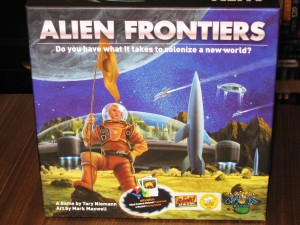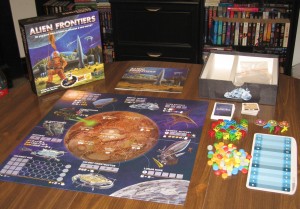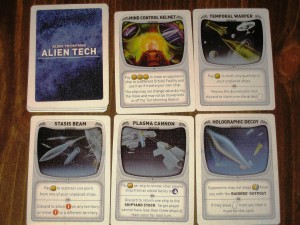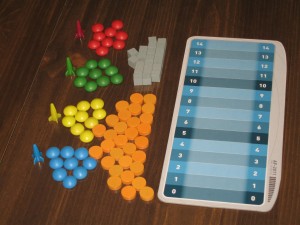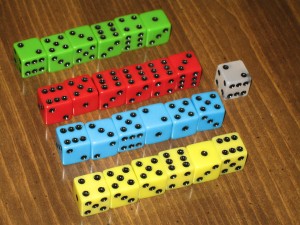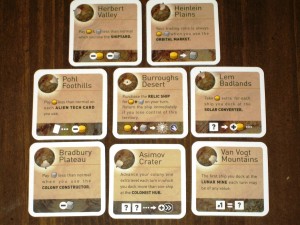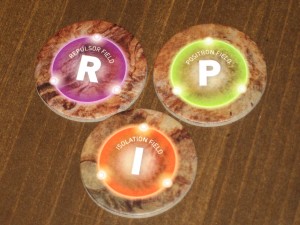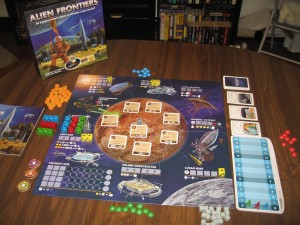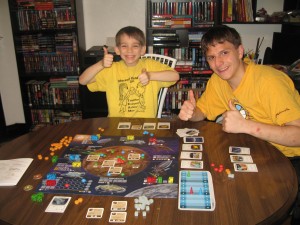It’s always been a dream of mine to at least see the day where mankind reaches beyond their own backyard and is able to settle down into the great unknown. Having been born in 1981, I can only imagine how the hopefuls and dreamers felt when they watched Neil Armstrong take his first steps on the moon surface in 1969. As such, I’ve always been interested in watching or playing anything science fiction themed…and I was equally excited when “Alien Frontiers” arrived unexpectedly in the mail a few days ago.
Before we begin taking a look at the game itself, I’d like to thank Clever Mojo Games and GameSalute for sending me a free copy of Alien Frontiers for me to review. If the names sound familiar, it’s because they are the same group of people who sent me Sunrise City. You can read that review here: Sunrise City.
Alien Frontiers is an area control and resource management game that tasks players with building colonies on a new, mysterious, alien planet. Each player will be given a fleet of ships, which they must use to collect resources, acquire technologies, and ultimately build colonies to earn victory points. Let’s take a look at the components, setup, and gameplay before heading into the review.
Components
Game Board – The board is made up of various sections. In the center of the board lies the planet, which is made of up territories. Players will be trying to colonize these territories. Surrounding the planet are various orbital facilities that players will be making use of in order to accomplish their objectives. Orbital facilities allow players to acquire resources, alien tech cards, and more.
Ships – Ships in this game come in the form of dice. There are six dice for each player color…red, yellow, green, and blue. There is also one clear die that serves as a special relic ship, which is controllable when purchased.
Ore and Fuel – The round, orange tokens are fuel and the square, grey cubes are ore. Both are resources that players will be trying to collect in order to build colonies, buy more spaceships, and etc.
Colonies – Players will be placing these dome-shaped pieces of their color onto various territories on the planet. Colonies are the main way to score points and also serve as a game over condition, that is, when one player runs out of colonies to place.
Alien Tech Cards – Three tech cards are available to be purchased at a time and provide their owners with special abilities. Some cards might change a digit on one of your dice, and others might prevent another player from stealing resources from you…just to name a few examples.
Territory Counters – As players place colonies on the planet, they will gain control of territories. These counters are given to the players currently in control of their respective territories (having the most colonies) and provide their owners with bonuses. One territory bonus might reduce the cost of buying ships from the shipyard while another might reward you with an extra fuel resource when assigning a ship to the solar converter orbital facility. Should another player manage to place an equal amount of colonies as the current territory leader, the territory counter is put back until there is a leader again.
Field Generators – There are three unique field generators that are placed by players when they utilize specific alien tech cards. They each have various effects on the territories that they are placed on. The positron field awards a victory point to the territory leader, in whichever territory it is placed on. The repulsor field prevents anyone from removing or placing colonies on whichever territory it is placed on. The isolation field prevents a territory leader from using their territory bonus, wherever it is placed.
Victory Point Scoreboard – This score track is a real-time look at who is winning, based on the current situation on the board. Players will be earning and losing points as the game goes on and the score markers (rockets) are adjusted accordingly. If players were to audit the scoreboard, they should always be able to account for every point each player has based on the current board layout.
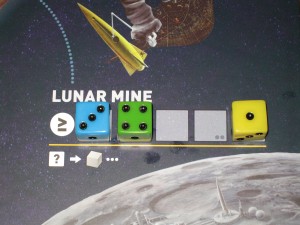
Orbital Facilities: Each orbital facility allows players to perform different actions. In this example, the lunar mine grants one ore per die, but players must place the die in equal or ascending order. The yellow die as shown is blocking one of the available spaces, per the three player variant rule set.
Setup
Game setup can vary, depending on how many players there are. The following is a brief overview of the rules:
1) The game board is placed in the center of the table.
2) The clear die and the territory counters are placed on their respective spaces on the planet, in the center of the board.
3) Three ships of each player color are placed on the maintenance bay location and the remaining three of each color remain off the board, but can be bought and used later on.
4) The alien tech deck is shuffled and three cards are drawn, which represent the available techs that can be purchased.
5) The ore and fuel tokens are placed near their respective orbital facilities (the lunar mine and solar converter, respectively).
6) The field generator counters and the scoreboard are placed nearby. The score markers (rockets) are placed on “0″.
7) Six colonies are given to each player. If players agree, they can be given all of them in order to play a longer game.
8) Players roll to determine start order. To compensate those not going first, they will receive various forms of compensation, depending on how many players are playing.
9) If there are less than four players, certain spaces on the board will be covered up by the unused dice.
Gameplay
Players will be taking turns performing the following actions:
1) Collect / Roll Dice – At the start of their turn, a player will collect the dice from their current positions on the board and roll them.
2) Place Dice / Play Cards – After rolling, players will be able to place the dice they rolled onto any empty orbital facility space. Players will also be able to play their tech cards, if they want to. If ANY player gains or loses victory points in the process, the scoreboard is adjusted accordingly.
3) After all of the dice are placed and cards have been played (optional), the player’s turn ends.
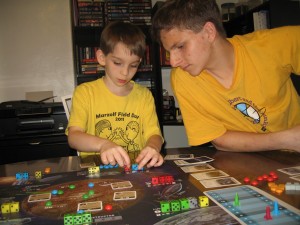
You can increase the amount of dice you roll and place by buying them at the shipyard. Even with six dice, you’ll often be pausing to figure out how best to place them.
Victory Points & Ending The Game
Players will be taking turns, attempting to score the most victory points before someone ends the game by placing all of their colonies. All victory points conditions are worth one point and can be earned as follows:
1) Placing a new colony.
2) Taking control of a territory. This involves having the MOST colonies in a territory.
3) Having an alien tech card that awards a point. There are two in the game.
4) Controlling the territory that contains a positron field, one of the three unique field generators.
The scoreboard should always reflect the current board layout!
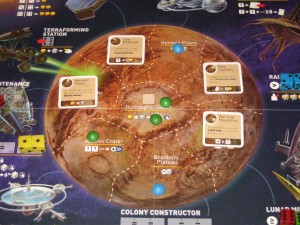
Players will often be going back and forth, wrestling territories and their bonuses away from each other.
The Review
First and foremost, I have to mention that the game came with extra zip bags. I am not sure why, but this always scores major points with me. I am a big fan of being organized, though some might call it OCD…whatever the case, thank you!
The artwork was attractive and the components were very well made. Having been a fan of certain retro science fiction shows, I was able to appreciate the overall theme. The board did a great job in helping us keep track of what each orbital facility did, and the manual was clear and concise. The manual prepared me well for the game, but some of the game mechanics I didn’t get until I actually saw them in action. For example, on our first turns, there was already a six on the lunar mine. Since you have to play a die of equal value or greater, I was worried that ore would be a rare commodity…until I realized that players retrieve their dice at the beginning of their turn, freeing up various spaces on the board and resetting certain orbital facility requirements.
It only took me about a half hour to review the manual in order to understand what was going on (for the most part). The kids picked up on my rules primer in just under ten minutes, though paused at times throughout the game to reason out the alien tech cards as they were drawn…but that’s normal with any game that offers a deck of varying cards. Unlike other games we’ve played, we were able to stick with the rules on our first playthrough without veering off course.
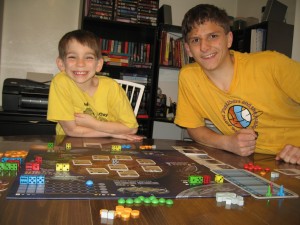
The boys rarely had the need to ask questions concerning the rules. Vinnie Jr, the eleven year old, caught on very quickly.
It’s easy to learn and easy to play, but the possibilities players will be presented with are always new and refreshing. It’s very rare to roll the exact same numbers on a regular basis and the board is always changing, so players will constantly be adapting to the current situation as it stands. This adds a ton of replayability to the game, in my opinion.
Anthony Jr, the sixteen year old, favored using the raiders’ outpost, which requires a three dice straight (3, 4, 5, etc). The raiders allow that player to steal an alien tech card or four resources from any player. I opted to stick to resource collecting rather than buying alien techs that could potentially save me from raiding, so I often found myself at the mercy of Anthony’s greedy eyes. He also had the most alien tech cards out of all of us, including the two victory point cards, which gave him a slight edge. He enjoyed his experience, commenting that this game was now tied for first as his favorite game in my collection.
Vinnie Jr, the eleven year old, favored building colonies using the colonist hub orbital facility. He was the last of us to invest in having six ships, but was the first to pump out colonies. He gained an early lead and utilized his territory bonuses to make his ships cost less. He too, enjoyed the game and expressed an interest in playing it again. The age requirement of 13+ had me worried a bit, but Vinnie caught on very quickly. I can see a bright ten-year old playing without any sort of problem, assuming that they had a patient teacher.
I, on the other hand, ignored the alien tech cards and collected as much ore and fuel as I could (limit of eight total resources). I was also forced to spend it as quickly as I could, lest Anthony steal those resources away from me. I pumped a lot of colonies out mid-game and earned myself the relic ship, allowing me to roll seven dice instead of my maximum of six. One of my territory bonuses allowed me to move my colony along the colonist hub track an extra space every time I assigned two or more ships there, so I made use of that every turn. I quickly became a mean, lean, colony machine and managed to empty my stock of colonies, ending the game with me in the lead.
To tell you the truth, I’ve always disliked games of chance. I’ve always prefered to settle my differences and test my mettle using logic and reason, however “Alien Frontiers” puts the best of both worlds into one, neat, highly replayable board game. Everything flowed together well and I found the game that much easier to understand once we began playing. I highly recommend “Alien Frontiers” for gamers of all kinds. I know that we’ll be pulling out this game on family fun night again in the very near future.
—
Final Verdict: 10/10
You can also find out more information about this game on Board Game Geek here:
Alien Frontiers – Board Game Geek
—

